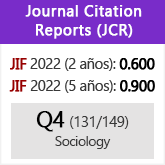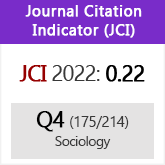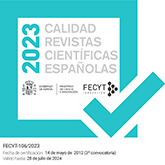Encarcelamiento, lazos familiares y reincidencia. Explorando los límites del familismo
DOI:
https://doi.org/10.3989/ris.2013.02.04Palabras clave:
Delincuencia, Desistimiento, Familia, Métodos mixtos, PrisiónResumen
Este artículo analiza los efectos en la reincidencia de los contactos familiares durante el encarcelamiento y explora los mecanismos explicativos que vinculan ambos factores, en un contexto en el que las familias ejercen un rol central en la provisión de bienestar. Para ello se plantea un diseño mixto, en dos olas, centrado en el estudio de hombres condenados a prisión por delincuencia común en la provincia de Barcelona. El análisis muestra que tanto los lazos familiares más fuertes (parejas y padres) como los más débiles (con otros familiares) tienen un efecto relevante en el proceso de desistimiento, aunque la forma en que operan es distinta (vínculo en el primer caso, apoyo en el segundo). Sin embargo, los resultados muestran también los límites del vínculo familiar cuando no va acompañado de los recursos materiales necesarios para conducir con éxito la transición postpenitenciaria. El análisis cualitativo permite profundizar en los factores explicativos e introducir varios matices a estas conclusiones mediante la observación de casos no confirmatorios.
Descargas
Citas
Almeda, E. 2003. Mujeres encarceladas. Barcelona: Ariel.
Alós, R., F. Esteban, P. Jódar, F. Miguélez, V. Alcaide i P. López-Roldán. 2011. La inserció laboral dels exinterns dels centres penitenciaris de Catalunya. Barcelona: Centre d'Estudis Jurídics i Formació Especialitzada.
Bahr, S., L. Harris, J. K. Fisher and A. H. Armstrong. 2010. "Successful reentry: what differentiates successful and unsuccessful parolees?". International Journal of Offender Therapy and Comparative Criminology 54:667-692. http://dx.doi.org/10.1177/0306624X09342435 PMid:19638473
Bales, W. and D. Mears. 2008. "Inmate social ties and the transition to society: does visitation reduce recidivism?". Journal of Research in Crime and Delinquency 45:287-321. http://dx.doi.org/10.1177/0022427808317574
Bandura, A. 1977. "Self-efficacy: Towards a unifying theory of behavioural change". Psychological Review 84:191-215. http://dx.doi.org/10.1037/0033-295X.84.2.191 PMid:847061
Berg, M. and B. Huebner. 2011. "Reentry and the ties that bind: An examination of social ties, employment, and recidivism". Justice quarterly 28:382-410. http://dx.doi.org/10.1080/07418825.2010.498383
Burnett, R. 1992. The dynamics of recidivism. Oxford: Centre for Criminological Research.
Burnett, R. and S. Maruna. 2004. "So 'prison works', does it? The criminal careers of 130 men released from prison under Home Secretary Michael Howard". The Howard Journal of Criminal Justice 43:390-404. http://dx.doi.org/10.1111/j.1468-2311.2004.00337.x
Calverley, A. 2013. Cultures of desistance: rehabilitation, reintegration, and ethnic minorities. London: Routledge.
Capdevila, M. y M. Ferrer. 2009. "Tasa de reincidencia penitenciaria 2008". Documento de trabajo (Investigación propia, 2008), Centre d'Estudis Jurídics i Formació Especialitzada, Barcelona. Consulta 24 de diciembre de 2012 (http://www20.gencat.cat/docs/Justicia/Documents/ARXIUS/SC-1-076-09_cas.pdf).
Castillo, J. y M. Ruiz. 2010. "Mujeres extranjeras en prisiones espa-olas. El caso andaluz". Revista Internacional de Sociología 68:473-498.
Cid, J. 2005. "The penitentiary system in Spain The use of imprisonment, living conditions and rehabilitation". Punishment & Society 7:147-166. http://dx.doi.org/10.1177/1462474505050439
Cid, J. 2009. "Is imprisonment criminogenic? A comparative study of recidivism rates between prison and suspended prison sanctions". European Journal of Criminology 6:459-480. http://dx.doi.org/10.1177/1477370809341128
Cid, J. and J. Martí. 2012. "Turning points and returning points: Understanding the role of family ties in the process of desistance". European Journal of Criminology 9:603-620. http://dx.doi.org/10.1177/1477370812453102
Cobbina, J., B. Huebner and M. Berg. 2012. "Men, women and postrelease offending: an examination of the nature of the link between relational ties and recidivism". Crime and delinquency 58:331-361. http://dx.doi.org/10.1177/0011128710382348
Cohen, J. 1968. "Weighted Kappa: Nominal scale agreement with provision for scaled disagreement or partial credit". Psychologica Bulletin 70:213-220. http://dx.doi.org/10.1037/h0026256
Comfort, M. L. 2003. "In The Tube At San Quentin. The 'Secondary Prisonization' of Women Visiting Inmates". Journal of Contemporary Ethnography 32:77-107. http://dx.doi.org/10.1177/0891241602238939
Cullen, F. T. 1994. "Social Support as an Organizing Concept for Criminology: Presidential Address to the Academy of Criminal Justice Sciences". Justice Quarterly 11:527-559. http://dx.doi.org/10.1080/07418829400092421
Cullen, F. T. and J. Wright. 1997. "Liberating the anomie-strain paradigm: Implications from social-support theory". Pp. 187-206 in The future of anomie theory, edited by A. N. Passas and R. Agnew. Boston: Northeastern University Press. PMid:9347475
Dixey, R. and J. Woodall. 2012. "The significance of the 'visit' in an English category-B prison: views form prisoners, prisoners' families and prison staff". Community, Work & Family 15:29-47. http://dx.doi.org/10.1080/13668803.2011.580125
Duwe, G. and V. Clark. 2013. "Blessed be the social tie that binds: the effect on prison visitation on offender recidivism". Criminal Justice Policy Review 24:271-296. http://dx.doi.org/10.1177/0887403411429724
Freedman, D., A. Thornton, D., Camburn D. D. Alwin and L. YoungdeMarco. 1988. "The life history calendar: a technique for collecting retrospective data". Sociological Methodology 18:37-68. http://dx.doi.org/10.2307/271044 PMid:12282712
García-Borés, J. 2003. "El impacto carcelario". Pp. 395-425 in Sistema penal y problemas sociales, editado por R. Bergalli. Valencia: Tirant lo Blanch.
García-Borés, P., N. Font, C. Fernández, R. Escurriol, A. Roig, H. Leyton y M. Moreno. 2006. La cárcel en el entorno familiar estudio de las repercusiones del encarcelamiento sobre las familias: problemáticas y necesidades. Barcelona: Ajuntament de Barcelona, Observatori del Sistema Penal i els Drets Humans-Universitat de Barcelona.
García-Espa-a E y J. L. Díez Ripollés, eds. 2012. Realidad y política penitenciarias. Valencia: Tirant lo Blanch.
Giordano, P. C., S. A. Cernkovich and L. Rudolph. 2002. "Gender, crime, and desistance:Toward a theory of cognitive transformation". American Journal of Sociology 107:990-1064. http://dx.doi.org/10.1086/343191
Giordano, P. C., S. A. Cernkovich and R. D. Schroeder. 2007. "Emotions and Crime over the Life Course: A Neo-Meadian Perspective on Criminal Continuity and Change". American Journal of Sociology 112:1603-1661. http://dx.doi.org/10.1086/512710
Glaser, D. 1964. The Effectiveness of a Prison and Parole System. Indianapolis, IN: Bobbs-Merrill. PMCid:PMC1898263
Hairston, C. F. 1988. "Family ties during imprisonment: Do they influence future criminal activity?". Federal Probation 52:48-52.
La Vigne, N. G., C. Visher and J. Castro. 2004. Chicago prisoners' experiences returning home. Washington, DC: The Urban Institute.
La Vigne, N. G., R. L. Naser, L. E. Brooks and J. L. Castro. 2005. "Examining the Effect of Incarceration and In-Prison Family Contact on Prisoners' Family Relationships". Journal of Contemporary Criminal Justice 21:314-335. http://dx.doi.org/10.1177/1043986205281727
Laub, J. and R. Sampson. 2003. Shared beginnings, divergent lives: Delinquents boys to age 70. Cambridge, MA: Harvard University Press.
Lebel, T., R. Burnett, S. Maruna and S. Bushway. 2008. "The 'Chicken and Egg' of Subjective and Social Factors in Desistance". European Journal of Criminology 5:131-159. http://dx.doi.org/10.1177/1477370807087640
Lemert, E. 1967. Human Deviance, Social Problems and Social Control. Englewood Cliffs, NJ: Prentice Hall. PMid:6049173
Lin, N. 1986. "Conceptualizing social support". Pp. 17-30 in Social Support, Life Events, and Depression, edited by N. Lin, A. Dean and W. M. Ensel. Orlando, FL: Academic Press. http://dx.doi.org/10.1016/B978-0-12-450660-2.50008-2
Martínez, D. and L. S. Abrams. 2013. "Informal social support among returning young offenders: A metasynthesis of the literature". International Journal of Offender Therapy and Comparative Criminology 57:169-190. http://dx.doi.org/10.1177/0306624X11428203 PMid:22094597
Maruna, S. 2001. Making Good. How Ex-Convicts Reform and Rebuild their Lives. Washington, DC: American Psychological Association. http://dx.doi.org/10.1037/10430-000
Mears D., J. Cochran, S. Siennick and W. Bales. 2012. "Prison visitation and recidivism". Justice Quarterly 29:888-918. http://dx.doi.org/10.1080/07418825.2011.583932
Mills, A. and H. Codd. 2008. "Prisoners' families and offender management: mobilizing social capital". Probation Journal 55:9-24. http://dx.doi.org/10.1177/0264550507085675
Moreno, L. 2001. "La 'vía media' espa-ola del modelo de bienestar mediterráneo". Papers, Revista de Sociologia 63/64:67-82.
Ohlin, L. E. 1951. Selection for Parole. New York: Russell Sage.
Petersilia, J. 2003. When Prisoners come Home. Parole and Prisoner Reentry. Oxford: Oxford University Press.
Poehlmann, J., R. J. Shlafer, E. Maes and A. Hanneman. 2008. "Factors Associated With Young Children's Opportunities for Maintaining Family Relationships During Maternal Incarceration". Family Relations 57:267-280. http://dx.doi.org/10.1111/j.1741-3729.2008.00499.x
Rodríguez, J., M. Rovira and E. Larrauri. 2013. "The Effect of Having an Incarceration Record on Young Spanish Males' Odds of Finding Employment." Paper presented at The American Society of Criminology Annual Meeting, Nov 19, Chicago, IL.
Sampson, R. and J. Laub. 1993. Crime in the making: Pathways and turning points through life. Cambridge, MA: Harvard University Press.
Sampson, R., J. Laub and C. Wimer. 2006. "Does marriage reduce crime? A counterfactual approach to within-individual causal effects". Criminology 44:465-506. http://dx.doi.org/10.1111/j.1745-9125.2006.00055.x
Savolainen, J. 2009. "Work, Family and Criminal Desistance. Adult Social Bonds in a Nordic Welfare State". British Journal of Criminology 49:285-304. http://dx.doi.org/10.1093/bjc/azn084
Schroeder, R. D., P. C. Giordano and S. A. Cernkovich. 2010. Adult child-parent bonds and life course criminality. Journal of Criminal Justice 38:562-571. http://dx.doi.org/10.1016/j.jcrimjus.2010.04.027
Shover, N. 1985. Aging criminals. Beverly Hills: Sage.
Siennick, S. and D. Osgood. 2008. "A review of research on the impact on crime of transitions to adult roles". Pp. 161-187 in The long view of crime: A synthesis of longitudinal research, edited by A. M. Liberman. New York: Springer. http://dx.doi.org/10.1007/978-0-387-71165-2_5
Small, M. L. 2011. "How to Conduct a Mixed Methods Study: Recent Trends in a Rapidly Growing Literature". Annual Review of Sociology 37:57-86. http://dx.doi.org/10.1146/annurev.soc.012809.102657
Visher, C. A. and D. O'Connell. 2012. "Incarceration and inmates' self perceptions about returning home". Journal of Criminal Justice 40:386-393. http://dx.doi.org/10.1016/j.jcrimjus.2012.06.007
Visher, C. A. and J. Travis. 2003. "Transitions from Prison to Community: Understanding Individual Pathways". Annual Review of Sociology 29:89-113. http://dx.doi.org/10.1146/annurev.soc.29.010202.095931
Vittinghoff, E. and C. E. McCulloch. 2007. "Relaxing the Rule of Ten Events per Variable in Logistic and Cox Regression". American Journal of Epidemiology 165:710-718. http://dx.doi.org/10.1093/aje/kwk052 PMid:17182981
Wakefield, S. and C. Uggen. 2004. "Having a Kid Changes Everything? The Effects of Parenthood on Subsequent Crime". Paper presented at the annual meeting of the American Sociological Association, August 18th, San Francisco, CA.
Wright, J. P., F. Cullen and J. Miller. 2001. "Family social capital and delinquent involvement". Journal of Criminal Justice 29:1-9. http://dx.doi.org/10.1016/S0047-2352(00)00071-4
Publicado
Cómo citar
Número
Sección
Licencia
Derechos de autor 2015 Consejo Superior de Investigaciones Científicas (CSIC)

Esta obra está bajo una licencia internacional Creative Commons Atribución 4.0.
© CSIC. Los originales publicados en las ediciones impresa y electrónica de esta Revista son propiedad del Consejo Superior de Investigaciones Científicas, siendo necesario citar la procedencia en cualquier reproducción parcial o total.Salvo indicación contraria, todos los contenidos de la edición electrónica se distribuyen bajo una licencia de uso y distribución “Creative Commons Reconocimiento 4.0 Internacional ” (CC BY 4.0). Puede consultar desde aquí la versión informativa y el texto legal de la licencia. Esta circunstancia ha de hacerse constar expresamente de esta forma cuando sea necesario.
No se autoriza el depósito en repositorios, páginas web personales o similares de cualquier otra versión distinta a la publicada por el editor.

















